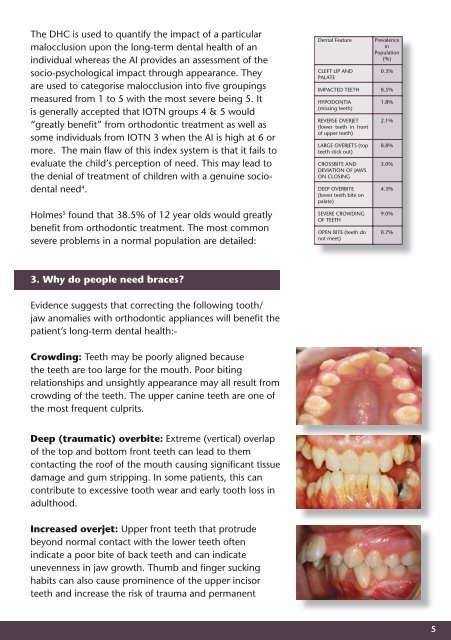Justification%20for%20orthodontic%20treatment
Justification%20for%20orthodontic%20treatment
Justification%20for%20orthodontic%20treatment
Create successful ePaper yourself
Turn your PDF publications into a flip-book with our unique Google optimized e-Paper software.
The DHC is used to quantify the impact of a particular<br />
malocclusion upon the long-term dental health of an<br />
individual whereas the AI provides an assessment of the<br />
socio-psychological impact through appearance. They<br />
are used to categorise malocclusion into five groupings<br />
measured from 1 to 5 with the most severe being 5. It<br />
is generally accepted that IOTN groups 4 & 5 would<br />
“greatly benefit” from orthodontic treatment as well as<br />
some individuals from IOTN 3 when the AI is high at 6 or<br />
more. The main flaw of this index system is that it fails to<br />
evaluate the child’s perception of need. This may lead to<br />
the denial of treatment of children with a genuine sociodental<br />
need 4 .<br />
Holmes 5 found that 38.5% of 12 year olds would greatly<br />
benefit from orthodontic treatment. The most common<br />
severe problems in a normal population are detailed:<br />
3. Why do people need braces?<br />
Evidence suggests that correcting the following tooth/<br />
jaw anomalies with orthodontic appliances will benefit the<br />
patient’s long-term dental health:-<br />
Crowding: Teeth may be poorly aligned because<br />
the teeth are too large for the mouth. Poor biting<br />
relationships and unsightly appearance may all result from<br />
crowding of the teeth. The upper canine teeth are one of<br />
the most frequent culprits.<br />
Deep (traumatic) overbite: Extreme (vertical) overlap<br />
of the top and bottom front teeth can lead to them<br />
contacting the roof of the mouth causing significant tissue<br />
damage and gum stripping. In some patients, this can<br />
contribute to excessive tooth wear and early tooth loss in<br />
adulthood.<br />
Increased overjet: Upper front teeth that protrude<br />
beyond normal contact with the lower teeth often<br />
indicate a poor bite of back teeth and can indicate<br />
unevenness in jaw growth. Thumb and finger sucking<br />
habits can also cause prominence of the upper incisor<br />
teeth and increase the risk of trauma and permanent<br />
Dental Feature Prevalence<br />
in<br />
Population<br />
(%)<br />
CLEFT LIP AND<br />
0.3%<br />
PALATE<br />
IMPACTED TEETH 8.5%<br />
HYPODONTIA<br />
(missing teeth)<br />
1.8%<br />
REVERSE OVERJET<br />
(lower teeth in front<br />
of upper teeth)<br />
LARGE OVERJETS (top<br />
teeth stick out)<br />
CROSSBITE AND<br />
DEVIATION OF JAWS<br />
ON CLOSING<br />
DEEP OVERBITE<br />
(lower teeth bite on<br />
palate)<br />
SEVERE CROWDING<br />
OF TEETH<br />
OPEN BITE (teeth do<br />
not meet)<br />
2.1%<br />
8.8%<br />
3.0%<br />
4.3%<br />
9.0%<br />
0.7%<br />
5


